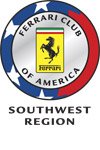
121 LM - 446 S - 735 S
Ferrari Market Letter article reprinted with permission
Purists will argue that "real" Ferraris have twelve cylinder engines. But more Ferraris have been built with V-8 engines than any other configuration. Nearly every Ferrarist is at least aware of the fact that the V-6 layout was once quite popular at Maranello, in Formula One, Formula Two, Sports/Racing, and production types. Those who have even a passing acquaintance with Ferrari?s history are aware of a period of flirtation with in-line four cylinder engines. An in-line six cylinder Ferrari? Are you sure we are talking about the same automobile company?
Indeed we are. Faced with the challenge from Mercedes Benz, Ferrari took the approach that more of a good thing was even better and enlarged the in-line four cylinder engines that had been successfully proven as far back as 1952? not by increasing the bore and/or stroke dimensions, but by increasing the number of cylinders. The four cylinder engines were developed originally to take advantage of their superior low-speed torque, and had successfully won Ferrari?s first World Championships in 1952 and 1953 with Alberto Ascari winning the Drivers World Championship. Capitalizing on this success, Ferrari put the in-line four into a sports racer in late 1953, and for 1954 continued their development.
In 1954 Mercedes Benz was dominant in Formula One, and when the German firm announced that in 1955 they would contest the World Championship of Makes with a sports car based on this F1 car, Ferrari know that there was a formidable challenger for the sports car championship it had won in 1953 and 1954.
The first in-line six was the Type 114, a three-liter engine with bore and stroke dimensions of 90 x 78 mm, identical to the four cylinder 500 Mondial engine. While specification for this engine and a 2,480 mm wheelbase chassis were published -- the car is usually referred to as the 306 S -- in late 1954, no evidence appears that it was ever raced. Next in the in-line six genealogy came the Type 115, and experimental 2.5-liter Formula One engine, and then the Type 118, which would be the first of the engines to see use in competition.
In simple terms, the Type 118 engine was a 625 four cylinder with two additional cylinders. With a bore and stroke of 94 x 90 mm, this gave a total displacement of approximately 3.7 liters. Most commonly known by the engine type number, hence 118 LM, this car also is the car that won Europe?s most prestigious sports car race, the 24 Hours of Le Mans. The engine was dry sump with dual ignition via two distributors and had, just like the four cylinder it was developed from, dual overhead camshafts. Depending upon the source consulted, it produced 280 to 310 horsepower. The chassis was quite similar to that of the 500 Mondial/750 Monza -- large diameter steel tubes with supplemental bracing by smaller tubes, independent front suspension with coil springs, a rear-mounted five-speed gearbox and rear suspension of de Dion type with transverse leaf spring -- but the wheelbase was enlarged to 2400 mm to accommodate the longer engine. Body work was by Scaglietti, and again bore an extremely close relationship to that of the in-line four cylinder cars.

The first appearance of the in-line six in competition was at the 1000 Km. of Buenos Aires on January 23, 1955, where a 118 LM was entered by the factory for Gonzalez/Trintignant. It set the fastest race lap but dropped out while running second due to fuel pump failure and an "unauthorized" shortcut into the pits. On April 3, the type made its European debut at the Tour of Sicily, where Taruffi won in an 118 LM. Next, on April 30 - May 1, came the Mille Miglia, and the introduction of a new in-line six, the 121 LM or 446 S or 735 S, depending on<
